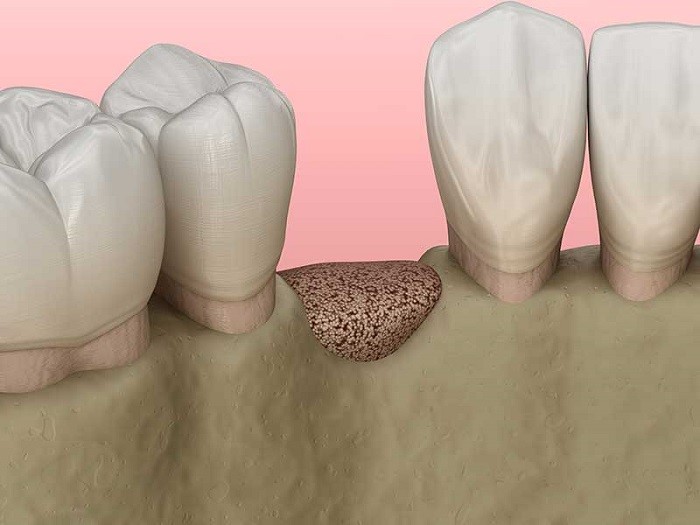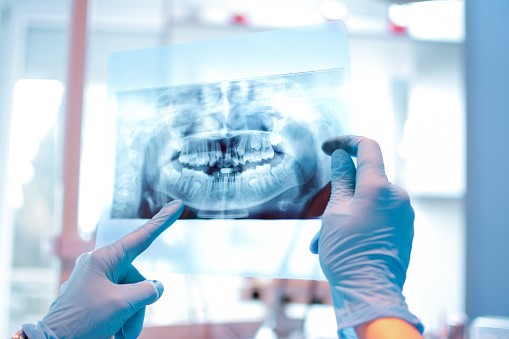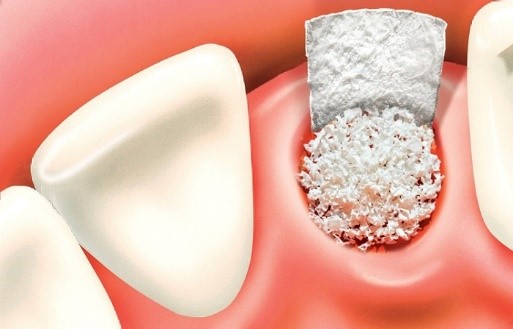Bone grafting gives dentists the ability to transplant bone grafts of proper length and width into the jawbone to form a stable foundation for dental implants, enabling patients to enjoy the functionality and aesthetic appearance of high-quality artificial teeth. High-quality dental implants look, feel, and function like natural teeth. For some people, the jawbone associated with missing teeth atrophies or is reabsorbed and is not substantial enough to support dental implants. In the past, this meant that many patients with deteriorated jawbones were not candidates for dental implants. Today, modern advances in oral surgery have allowed surgeons to grow bone where it is needed by using a procedure called bone grafting.
Bone grafting is an effective approach to repairing implant sites with inadequate bone structure. Since bone tissue is able to regenerate and grow, strategic placement of bone grafts can encourage bone growth where it is needed. After the graft has been placed, the bone generally needs to heal for a period of four to nine months.
What Causes Jawbone Atrophy?
When natural teeth roots are present within the jawbone, they stimulate the bone by transmitting the normal stresses encountered during chewing. These stresses cause NORMAL bone turnover and this process preserves the existing bone structure. When teeth are lost or removed, the bone is no longer stimulated and bone resorption begins. Why? The jawbone then translates this lack of stimulation to mean it is no longer needed. As a result, bone atrophy occurs over time.
This is why individuals who have been missing teeth for a long time may have a gaunt or hollowed appearance. When dental implants are used to replace missing teeth, they actually mimic the natural roots. Therefore, the the jawbone is stimulated once again, preventing further bone loss in the future.
When is Bone Grafting Necessary?
There are a variety of reasons why the amount of bone in the jaw may need to be increased:
Implants
Dental implants and other restorative procedures depend on the jawbone being sufficiently strong and thick. When periodontal disease has taken hold, the jawbone may have become too thin to successfully support an implant. Natural bone regeneration (or bone grafting) is one of the best ways to promote growth and thicken the jawbone.
This might be done several months ahead of time or in conjunction with implant placement. Implants that are to be placed in the upper back jaw present a special problem. The hollow maxillary sinus in the bone can complicate the placement of an implant. Here, a special procedure, known as a sinus lift or sinus augmentation, may be required in conjunction with the graft to regenerate enough bone to support an implant.
Conventional Dentures and Partials
A denture or partial needs to rest on a thick jawbone to have a stable base. If the ridge of the jaw is thin and weak, bone grafting may be useful.
Aesthetics
Jawbone regeneration may be indicated to replace jawbone lost in a front, visible area of the mouth that is to be restored with a prosthesis or implant. With the bone restored, the prosthesis can be much more aesthetic.
Congenital
Patients with congenital conditions, such as cleft palate, may have a deficiency in jawbone density that requires regeneration.
Pathology
Those who have lost bone due to cysts and other types of jaw tumors may profit from a jawbone regeneration procedure.
DONOR BONE VS. ARTIFICIAL BONE GRAFTS
The material used for a bone grafting procedure is determined by several factors and varies from case to case. Large defects are generally repaired using the patient’s own bone. If oral surgeons determine that this is the best course of action in your individual case, the graft will be harvested from your jaw, skull, hip, or lateral knee, depending on the amount of bone needed for the graft.
Major bone grafts are typically performed to repair defects of the jaw that result from traumatic injuries, tumor surgery, or congenital defects. In other cases, bone from cadavers or synthetic materials may be used for the graft. Additionally, bone morphogenic protein (BMP) can be used to stimulate the formation of new bone. This product can be used in lieu of grafting a patient’s own bone, avoiding a donor site, and providing the best possible bone for implants.
the density of the jawbone can be improved using donor bone or artificial bone grafts. There are a few options for this:
- Autogeous Grafts – These bone grafts are taken from the donor’s own body.
- Allografts – Allografts are grafts that are taken from another human donor.
- Xenografts – These kinds of bone grafts are derived from animals, typically bovine sources.
- Synthetic Grafts – These artificial bone grafts may be created from different kinds of substances.
Since each patient has unique needs, the ideal type of bone graft can be discussed in greater detail with your oral surgeon.
IDEAL CANDIDATES FOR JAWBONE REGENERATION
The ideal candidates for jawbone regeneration should be in good overall health so that an oral surgery procedure will not pose a risk to overall wellness. They should also have realistic expectations when it comes to the nature of the surgery and the side effects experienced after the surgery has been performed.
it’s important for patients to have realistic expectations when it comes to the treatment timeline for jawbone regeneration and implant dentistry. Undergoing the grafting procedure in addition to the dental implants procedure will add more time to the overall treatment process. Keep in mind that this added time is crucial for ensuring the best results possible.
During the consultation process, you will be able to discuss a treatment timeline for bone grafting and the osseointegration of the dental implant, and you may also discuss various alternatives to implant dentistry if you wish.
HOW JAWBONE REGENERATION WORKS?
During jawbone regeneration, an oral surgeon places donor bone or artificial hard tissue along the dental arch. This hard tissue fuses with the original bone structure of the jaw and helps increase the density of the dental arch. Thanks to jawbone regeneration, patients will achieve normal bone density and be able to receive dental implants.
Initially, bone grafting material is obtained from elsewhere on the body or from a bone bank. The gums are gently pulled back, and an opening is made in the jawbone where the grafting material will be packed in tightly. A membrane is used to maintain the shape of the new bone, and tissue stimulating proteins and a platelet-rich growth factor may be applied to promote faster healing. The surgical site will be sutured and packed with protective material. The bone will naturally regenerate and become strong enough to eventually support an implant.
RECOVERY
Following the jawbone regeneration procedure, patients will have a a recovery period that will last several weeks to a few months. The new bone tissue must join and grow with the existing jawbone in order for the procedure to be successful. Oral surgeons will provide their patients with detail instructions about the post-op process and what can be done to ensure proper and rapid recovery.
Faq
WHAT ARE SOME COMMON SIDE EFFECTS AFTER A BONE GRAFT?
You may experience slight discomfort, swelling, or bleeding following your bone graft procedure. Any discomfort can be soothed through prescribed oral medications. Swelling is your body’s natural reaction to a bone graft. Swelling may not be immediately present and may form one to two days following your bone graft procedure. The application of ice packs can help reduce the severity of swelling. Finally, a small degree of bleeding is normal along your incisions. We may place a sterile gauze pad after your bone graft to keep your incisions clean. Bleeding should subside a few hours following your bone graft surgery.
HOW LONG WILL I NEED TO WAIT AFTER A BONE GRAFT TO RECEIVE DENTAL IMPLANTS?
While the recovery time is different for each patient and depends on the extent of bone grafting and your body’s own rate of healing, the majority of patients wait between four to nine months after a bone graft before receiving dental implants. This recovery period allows for your bone graft to effectively bond with your existing jawbone. After a successful bone graft, you will have sufficient bone density to support dental implants.
HOW CAN A BONE GRAFT HELP ME WHEN MY JAW IS NOT WIDE ENOUGH FOR IMPLANTS?
For some patients, the jaw isn’t wide enough to support dental implants, and a bone graft is needed to alter the height or width of the jawbone. This technique is called a ridge expansion and restores the jawbone to make it wide enough to support conventional dental implants. During a ridge expansion, oral surgeons will use a special saw to carefully divide the jaw along the top ridge, expanding the width of the jaw and creating enough space to insert bone grafts. For some patients, dental implants can be placed immediately following the ridge expansion. In other cases, the bone will need time to heal first. oral surgeons will discuss the specifics of your case with you during your initial consultation.






